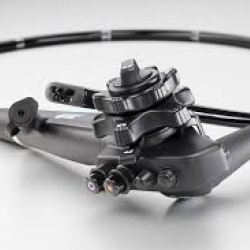Bacteria that are resistant to one, multiple or even all known antibiotics, commonly known as superbugs, are one of the leading concerns in the medical and scientific communities.
With the traditional methods of combating bacterial infections not working - alternative ways to stop the infections from starting or, at least, from spreading - are necessary. This would mean cutting down on the number of infections and because many of these infections are nosocomial (acquired while someone is staying in the hospital) spread through the use of contaminated instruments - clean instruments are an imperative first step to stop the bacteria's spread.
But, many medical devices are incredibly difficult to clean well enough to stop the spread of bacteria. They may have hard to reach areas or are unable to withstand harsher sterilization methods.
A duodenoscope is threaded through the patient's mouth and used to visualize the stomach and duodenum (the upper gastrointestinal (GI) tract). It can also be used to drain fluids from pancreatic and biliary ducts that would otherwise require more invasive surgery. These scopes, about a half inch or less in diameter have channels to 1) introduce instruments, like needles and biopsy forceps, 2) provide fiberoptic light bundles to illuminate and see the stomach and intestines, and 3) control wires to help navigate the instrument through the stomach and duodenum. They contain sophisticated expensive technology compacted into nooks and crannies. And while the nooks reduce the size, they also make it harder to really clean the instrument.
Duodenoscopes have been linked to outbreaks in the past, with the FDA citing 350 patients at 41 medical facilities being infected as a result of contaminated duodenoscopes from January 2010 to October 2015.
This week, the U.S. Food and Drug Administration (FDA), took a step in the right direction by approving a new tool to add in the fight against superbugs - the ED34‑i10T Video Duodenoscope made by Pentax Medical.
This is not your ordinary, everyday duodenoscope. The key component, for our purposes, is not its lightweight or ergonomical design that prevents hand fatigue. No - it's the cap covering the end of the device - the place where the instruments pass through and the lens on the fiber optic cables are located. The cap is disposable and that's a big deal because it can be removed from the instrument and the channels can be cleaned.
In making that one change, the instrument can be cleaned thoroughly enough to prevent spread of bacteria from one patient to another - stopping superbug infections in their tracks. That is important because this type of instrument is used in more than a half a million procedures each year.
“We believe the new disposable distal cap represents a major step towards lowering the risk of future infections associated with these devices,” said William Maisel, M.D., M.P.H., acting director of the Office of Device Evaluation in the FDA’s Center for Devices and Radiological Health. “Improving the safety of duodenoscopes is a top priority for the FDA, and we encourage companies to continue to pursue innovations that will help reduce the risk to patients.”
Other ideas are favored by some medical professionals, including disposable duodenoscopes. Although removing the risk of infection is appealing, the lack of sophistication in an instrument inexpensive enough to be thrown away is not the best solution to many of those using and relying on them for making accurate diagnoses. Additionally, disposable instrumentation bucks the trend towards “greener” hospitals reducing the environmental impact of healthcare’s waste materials. Another hope is for duodenoscopes that can be fully sterilized, however, it will take time to make these relatively delicate and intricate instruments tough enough to stand up to that type of treatment.
Until something better comes along, Pentax's duodenoscope with the removable tip will have to do. In it, they kept the high quality and factored in a way to clean it more effectively and thoroughly - hopefully cutting down on the spread of superbugs. Because the last thing that you should take away from an upper GI procedure is a bacterial infection that could kill you.
Reference:
FDA News Release: FDA clears first duodenoscope with disposable distal cap https://www.fda.gov/NewsEvents/Newsroom/PressAnnouncements/ucm576753.htm

